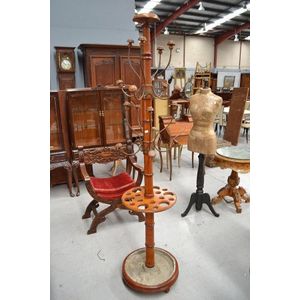
Late Victorian Cast Iron Hall Stand with Mirror and Hooks
A late Victorian cast iron hall stand, late 19th century, the openwork architectural back centred by an octagonal bevelled edged mirror and set with five coat hooks, with floral, urn and geometric pierced motifs, above an umbrella stand and a lower…

French 19th Century Faux Bamboo Cast Iron Umbrella Stand
A pale-green painted faux bamboo design cast iron umbrella stand, French 19th century, with removable water tray, 69 cm high, 53 cm wide, 23 cm deep

Bamboo Hall Stand - Antique, Compact and Elegant
Antique bamboo hall stand 59 cm wide, 40 cm deep, 154 cm high.

Stylish Cane Coat Stand: Strong and Unique
A cane coat stand, unique statement piece. Strong and sturdy quality cane. Height 195 cm, width 60 cm

Late 19th Century Bamboo Hallstand
A Japanese style bamboo hallstand, late 19th century, 200 cm high, 100 cm wide, 35 cm deep

Chinoiserie Umbrella Stand with Walking Canes
A Toileware umbrella stand containing three walking canes, the stand painted red with gilt Chinoiserie decoration, one cane with sterling silver top, the other two horn handled. The umbrella stand 48 cm high.

Bamboo Seagrass Gypsy Hall Stand with Magazine Rack
Vintage bamboo and seagrass gypsy hall stand with magazine rack

Antique Bamboo Hall Stand with Coat Rack and Stick Stand
Antique Aesthetic movement bamboo hall stand with coat rack hangers and stick stand section, 97 cm wide, 33 cm deep, 203 cm high

French Fruitwood Bamboo Coat Rack
A small carved fruitwood bamboo form hanging coat rack, French 19th century, width 59 cm, height 17 cm

French Aesthetic Cast Iron Hall Stand, Circa 1900
A striking French Aesthetic movement cast iron hall stand, circa 1900, crafted as a geometric arrangement of black bamboo, with eight double hooks, central mirror and an extended base for sticks and umbrellas with twin drip, tray, height 196 cm, width 72…

French Faux Bamboo Coat Rack & Hallstand - Antique
Antique French faux bamboo coat rack / hallstand, 233 cm high, 82 cm wide

French Faux Bamboo Hall Stand, Circa 1890
An antique French faux bamboo hall stand, circa 1890. 204 cm high, 80 cm wide, 22 cm deep

Folding Faux Bamboo Wall Coat Rack, French 1900
An ebonised folding faux bamboo wall coat rack, French, circa 1900, 112 cm wide

French Cast Iron Bamboo Umbrella Stand, 1920
A cast iron bamboo form umbrella stand, French, circa 1920. 60 cm high, 49 cm wide, 23 cm deep

French Enamelled Cast Iron Faux Bamboo Umbrella Stand
Antique French enamelled cast iron umbrella stand, faux bamboo design, approx 65 cm high, 53 cm high

French Faux Bamboo Coat Rack - Antique
Antique French faux bamboo coat rack, approx 76 cm long, 43 cm wide

Faux Bamboo Coat Stand with Metal Hooks
Coat stand faux bamboo coat stand with metal hooks France, c. 1920s. 187 cm high, 78 cm wide, 22 cm deep

Faux Bamboo Coat Stand with Umbrella Tray (1930s)
Coat stand faux bamboo coat stand with umbrella tray France, c. 1930s. 200 cm high, 70 cm wide, 25 cm deep

Faux Marble Umbrella Stand with Tin-Lined Trough
A faux marble umbrella stand, configured as a demi-lune section pierced to hold numerous sticks and umbrellas raised above a trough with tin lining of conforming shape. Width 90 cm

French Faux Bamboo Coat Rack & Umbrella Stand
Antique French faux bamboo coat rack and umbrella stand, with zinc lined drip tray, approx 203 cm high

Turquoise Bamboo Umbrella Stand with Drip Tray - 78cm
Turquoise enamel cast iron bamboo umbrella stand with drip dray, approx 78 cm high, 52 cm wide

Victorian Bamboo Umbrella Stand with Drip Tray
Victorian painted cast iron bamboo umbrella stand with drip tray, approx 60 cm high, 39 cm wide

French White Panelled Hall Stand, circa 1900
A white painted brass, steel and cane panelled hall stand, French, circa 1900. Approx 220 cm high, 100 cm wide

French Bamboo Hallstand - 230cm High
Antique French bamboo hallstand, approx 230 cm high, 98 cm wide

Bamboo Hallstand with Diamond Mirror
Antique bamboo hallstand, fitted with a central diamond shape mirror, approx 222 cm high, 81 cm wide

Bamboo Hallstand with Mirror and Coat Hooks
An Aesthetic style bamboo hallstand, early 20th century, the rustic tall stand with a five coat hooks, a bevelled mirror set as diamond above a conforming painted timber panel of roses, the base with provision for umbrellas and walking sticks above a…








 Loading more...
Loading more...